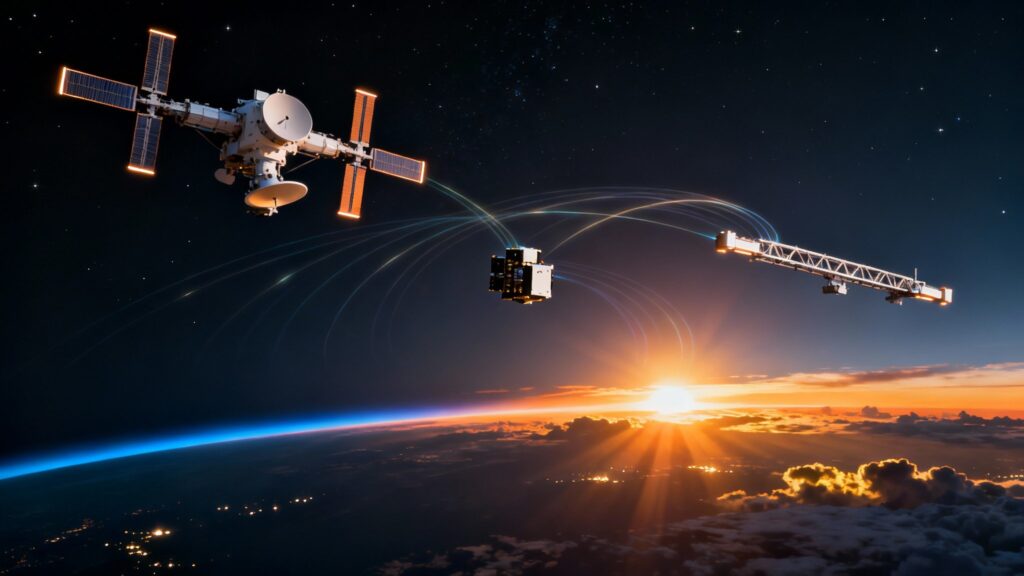Tech giant unveils groundbreaking plan to deploy solar-powered satellites equipped with AI chips, potentially revolutionizing how we power artificial intelligence

Google has just announced something that sounds straight out of science fiction. The company revealed Project Suncatcher, an ambitious research initiative to launch AI data centers into space. Yes, you read that right data centers floating in orbit, powered by the sun.
This isn’t just some far-fetched fantasy. Google is dead serious about this moonshot project, and they’ve already started testing the hardware. The company plans to launch two prototype satellites by early 2027 in partnership with satellite maker Planet Labs. Each satellite will carry Google’s custom AI chips, known as Tensor Processing Units (TPUs), which currently power many of the company’s AI models here on Earth.
Why Space? The Energy Crisis Driving Innovation
Here’s the thing: AI is incredibly power-hungry. Like, ridiculously power-hungry.
According to the International Energy Agency, energy consumption by AI data centers is projected to double to 945 terawatt-hours by 2030 that’s nearly 3% of global energy demand. Data center electricity consumption is expected to grow by around 15% per year through 2030, more than four times faster than all other sectors combined.
Traditional data centers are driving up power plant emissions and utility bills through soaring electricity demand. They’re dirty, noisy, and ravenous for power and water. Communities are increasingly opposing plans to build them nearby. Google’s solution? Take them off the planet entirely.
“In the future, space may be the best place to scale AI compute,” writes Travis Beals, Google’s senior director for Paradigms of Intelligence, in a blog post announcing the project.
The Solar Power Advantage
The sun is the ultimate energy source in our solar system, emitting more power than 100 trillion times humanity’s total electricity production. But here’s the kicker: in the right orbit, a solar panel can be up to eight times more productive than on Earth.
Why such a massive difference? It’s all about continuous exposure. On Earth, solar panels lose power at night and production drops significantly during winter. Weather, atmospheric interference, and the day-night cycle all limit terrestrial solar installations.
In space, it’s a different story. Google envisions placing satellites in a “dawn-dusk sun-synchronous low-earth orbit” where they would be exposed to near-constant sunlight. This orbital choice maximizes solar energy collection and dramatically reduces the need for heavy onboard batteries. The satellites would essentially bask in uninterrupted sunshine, generating electricity almost continuously.
The Technical Challenges: Not for the Faint of Heart
Of course, launching data centers into space isn’t exactly a walk in the park. Google faces several major technical hurdles that would make even the most seasoned engineers break a sweat.
Communication is Key
First up: getting the satellites to talk to each other. To rival ground-based data centers, these orbital systems need to support data transfer rates of tens of terabits per second. That’s an astronomical amount of data flying through space.
Google’s solution involves positioning satellites in extremely tight formations we’re talking kilometers or even just hundreds of meters apart. That’s much closer than satellites operate today. For context, current satellite constellations like Starlink maintain distances of roughly 120 kilometers between satellites.
The company has already begun testing this approach with a bench-scale demonstrator that successfully achieved 800 Gbps each-way transmission (1.6 Tbps total) using a single transceiver pair. But scaling this up to a full constellation presents significant challenges.
Space Junk and Orbital Dynamics
Flying satellites in such tight formation introduces serious risks. Space debris from past collisions already threatens active satellites, and closer groupings amplify collision probabilities. Google acknowledges these challenges as critical to the project’s feasibility.
The company developed sophisticated physics models to analyze the orbital dynamics of such a constellation. Using approximations based on the Hill-Clohessy-Wiltshire equations and a JAX-based differentiable model, they’ve shown that satellites positioned just hundreds of meters apart would require only “modest station-keeping maneuvers” to maintain stable formations.
Still, maneuvering constellations of satellites into tight formations while avoiding space junk is no small feat. It requires robust collision avoidance systems and ongoing orbital debris monitoring.
Radiation: The Silent Killer

Here’s something most people don’t think about: space is incredibly hostile to electronics. Unlike Earth environments, orbits subject hardware to intense cosmic and solar radiation that can degrade performance and cause failures.
Google conducted extensive radiation testing on its latest Trillium TPUs to assess their durability. They blasted the chips with a 67MeV proton beam to simulate years of solar exposure in space. The results? Surprisingly promising.
While the High Bandwidth Memory (HBM) subsystems were the most sensitive component, they only began showing irregularities after a cumulative dose of 2 krad(Si)—nearly three times the expected five-year mission dose of 750 rad(Si). No hard failures occurred up to the maximum tested dose of 15 krad(Si), indicating that Trillium TPUs are surprisingly radiation-hard for space applications.
“They held up quite well,” Beals said, suggesting the chips could easily handle a five- or six-year mission.
The Economics: Will It Actually Be Affordable?
Let’s talk money. Launching stuff into space is expensive. Really expensive. Currently, it costs roughly $1,500 per kilogram on a SpaceX Falcon Heavy rocket. At those prices, space-based data centers would be prohibitively expensive.
But Google isn’t planning for today—they’re planning for the 2030s. The company’s analysis of historical and projected launch pricing data suggests that with a sustained learning rate, prices may fall to less than $200 per kilogram by the mid-2030s.
At that price point, something remarkable happens: the cost of launching and operating a space-based data center could become “roughly comparable” to the energy costs of an equivalent terrestrial data center on a per-kilowatt-year basis.
This projection assumes continued innovation in reusable rocket technology, primarily from companies like SpaceX. The company’s under-development Starship could significantly improve launch economics and reduce emissions per kilogram of payload.
Google’s Moonshot Tradition
Project Suncatcher fits squarely into Google’s long tradition of pursuing ambitious “moonshots”—projects so audacious they have high potential rewards but low probability of success.
The concept comes straight from the company’s eccentric founders, Larry Page and Sergey Brin, who saw the massive profit margins from search advertising as a means to build something much more interesting than just an internet cash cow.
Some of Google’s moonshots haven’t panned out. Project Calico was tasked with solving death. Project Loon tried to use high-altitude balloons to deliver internet to remote areas. Verily wanted to make glucose-monitoring contact lenses. None of these have achieved their original goals.
But others have succeeded spectacularly. Self-driving cars seemed impossible 15 years ago, but now Waymo vehicles serve millions of passenger trips around the globe. Advanced artificial intelligence was once considered science fiction, and now it’s reshaping entire industries.
The Competition: A New Space Race?
Google isn’t alone in this vision. Tech moguls Elon Musk and Jeff Bezos have both mused about putting GPUs in space. Musk tweeted last week about pursuing the same ambition, noting that SpaceX already has a foundation in Starlink, the satellite internet constellation.
A startup called Starcloud successfully launched its first test satellite, outfitted with an Nvidia AI GPU, this past weekend. The company has partnered with Nvidia and plans to build what look more like traditional data centers in space, with modular containers filled with server racks.
Google’s approach differs significantly. Rather than launching large, bulky server racks, the company envisions fleets of small satellites connected wirelessly. This modular design reduces the need to carry massive hardware on rockets and aligns with Google’s historical approach of using cheaper hardware with sophisticated software to work around limitations.
Environmental Concerns and Considerations
While space-based data centers promise clean solar energy, they’re not without environmental concerns. A European Union-funded study questioned the net-positive carbon impact, considering the carbon footprints of rocket launches and upper atmosphere emissions.
“The results of our study indicate that data centers in space become more interesting than terrestrial data centers if and only if the launcher can be reusable and that it emits less than 370 kgCO2/kg of payload on average over its entire lifespan,” the researchers wrote.
This caveat is important. The environmental benefits only materialize if launch technology continues improving. Fortunately, reusable rockets like SpaceX’s Falcon 9 and the upcoming Starship are moving in that direction.
What Happens Next?
Google’s roadmap is clear, if ambitious. The company is partnering with Planet Labs to launch two prototype satellites by early 2027. This learning mission will test how models and TPU hardware operate in actual orbital conditions, gathering crucial data on power generation, communication, and radiation effects.
The experiment will validate the use of optical inter-satellite links for distributed machine learning tasks. It’s a critical proof-of-concept that will determine whether the physics and engineering actually work as predicted.
Beyond the initial test, significant engineering challenges remain. Thermal management in the vacuum of space is particularly tricky—without air to carry away heat, cooling requires sophisticated systems of heat pipes and radiators. High-bandwidth ground communications and on-orbit system reliability also need solutions.
“We’ve spent the past year or so trying to think through, what are all the ways this might not work? Can we prove it can’t work? And we’re still here because we haven’t seen any obvious showstoppers,” Beals said in an interview.
The Bigger Picture: Redefining Possible

Whether Project Suncatcher succeeds or fails, it represents something important: a willingness to think radically different about infrastructure challenges.
A decade ago, the idea of building data centers with millions of AI chips—even on Earth—would have sounded nuts. Now it’s commonplace. The technology inside data centers could change dramatically over the next decade, creating unforeseen challenges or opportunities.
And let’s be honest: stuff goes wrong in space. Satellites fail. Radiation causes unexpected problems. Orbital mechanics are unforgiving. The project faces long odds.
But we’re living in highly-capitalized, moonshot times. If AI is truly important to scientific progress and national security, perhaps the government should accelerate the timeline by contracting with Google and SpaceX to make this happen sooner.
Just like the original moonshot—the one where Americans actually landed on the moon—it would surely lead to new technology and economic benefits down the road. Sometimes the journey matters as much as the destination.
For now, Google is taking the first steps on what could be a transformative journey. By 2027, we’ll see whether those first prototype satellites can survive and thrive in orbit. If they do, the 2030s might see a new kind of infrastructure emerge—one that literally reaches for the stars.
Sources
- The Verge – Google has a ‘moonshot’ plan for AI data centers in space
- 9to5Google – Google’s next moonshot is putting TPUs in space with ‘Project Suncatcher’
- Dataconomy – Google plans orbital AI data centers powered by the sun
- Ars Technica – Meet Project Suncatcher, Google’s plan to put AI data centers in space
- Construction Review Online – Google unveils Project Suncatcher to build AI data centers in space
- The Daily Tech Feed – Google launches Project Suncatcher: Space-based AI compute with solar-powered satellite network
- Google Research Blog – Exploring a space-based, scalable AI infrastructure system design
- Hindustan Times – Google wants to build AI data centres in space, powered by the sun
- Semafor – Google wants to build solar-powered data centers — in space










